Business Finance
VerifiedAdded on 2023/01/04
|14
|3267
|51
AI Summary
make sure you follow the instructions from the assignment brief, thank you
Contribute Materials
Your contribution can guide someone’s learning journey. Share your
documents today.

BUSINESS FINANCE
Secure Best Marks with AI Grader
Need help grading? Try our AI Grader for instant feedback on your assignments.
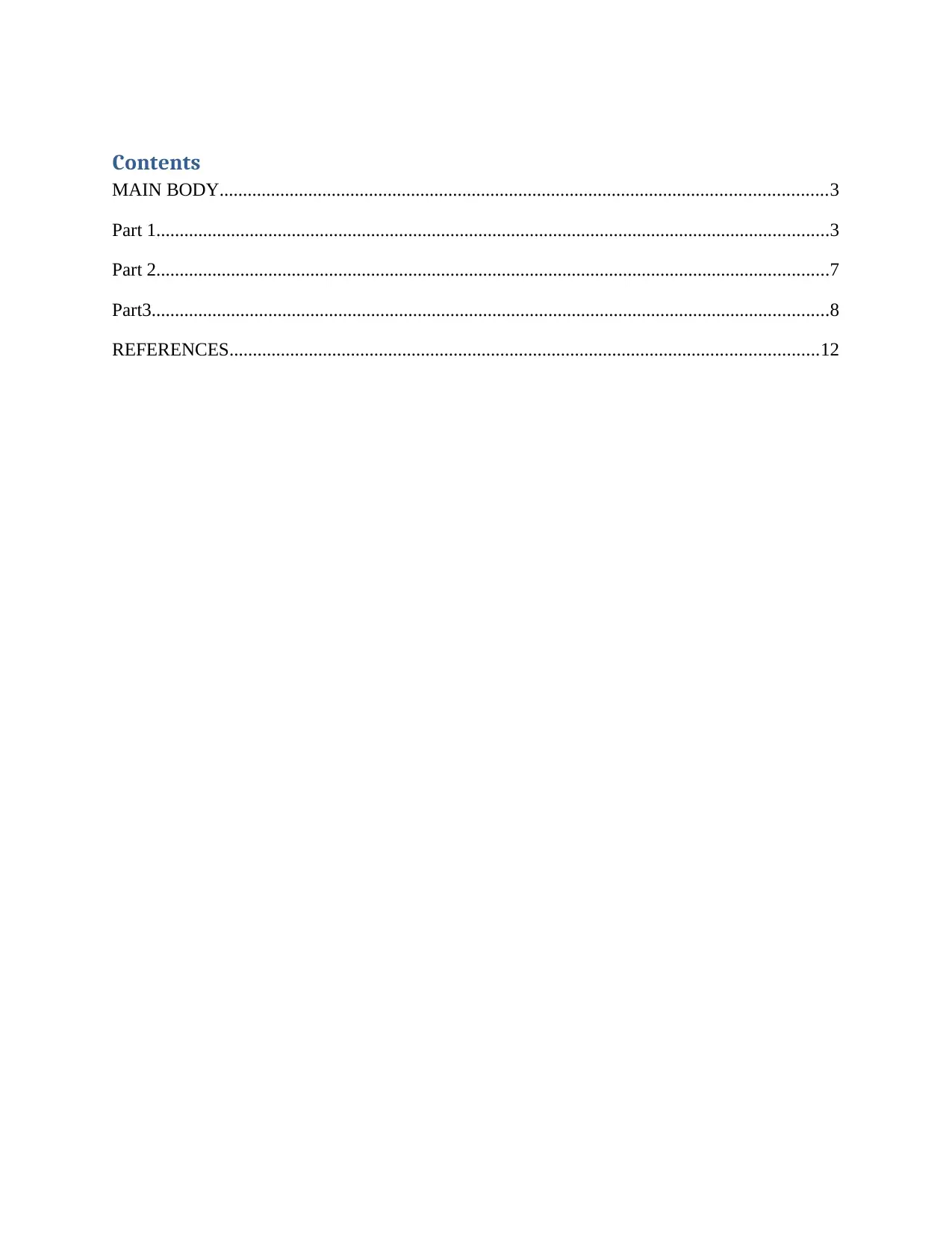
Contents
MAIN BODY..................................................................................................................................3
Part 1................................................................................................................................................3
Part 2................................................................................................................................................7
Part3.................................................................................................................................................8
REFERENCES..............................................................................................................................12
MAIN BODY..................................................................................................................................3
Part 1................................................................................................................................................3
Part 2................................................................................................................................................7
Part3.................................................................................................................................................8
REFERENCES..............................................................................................................................12
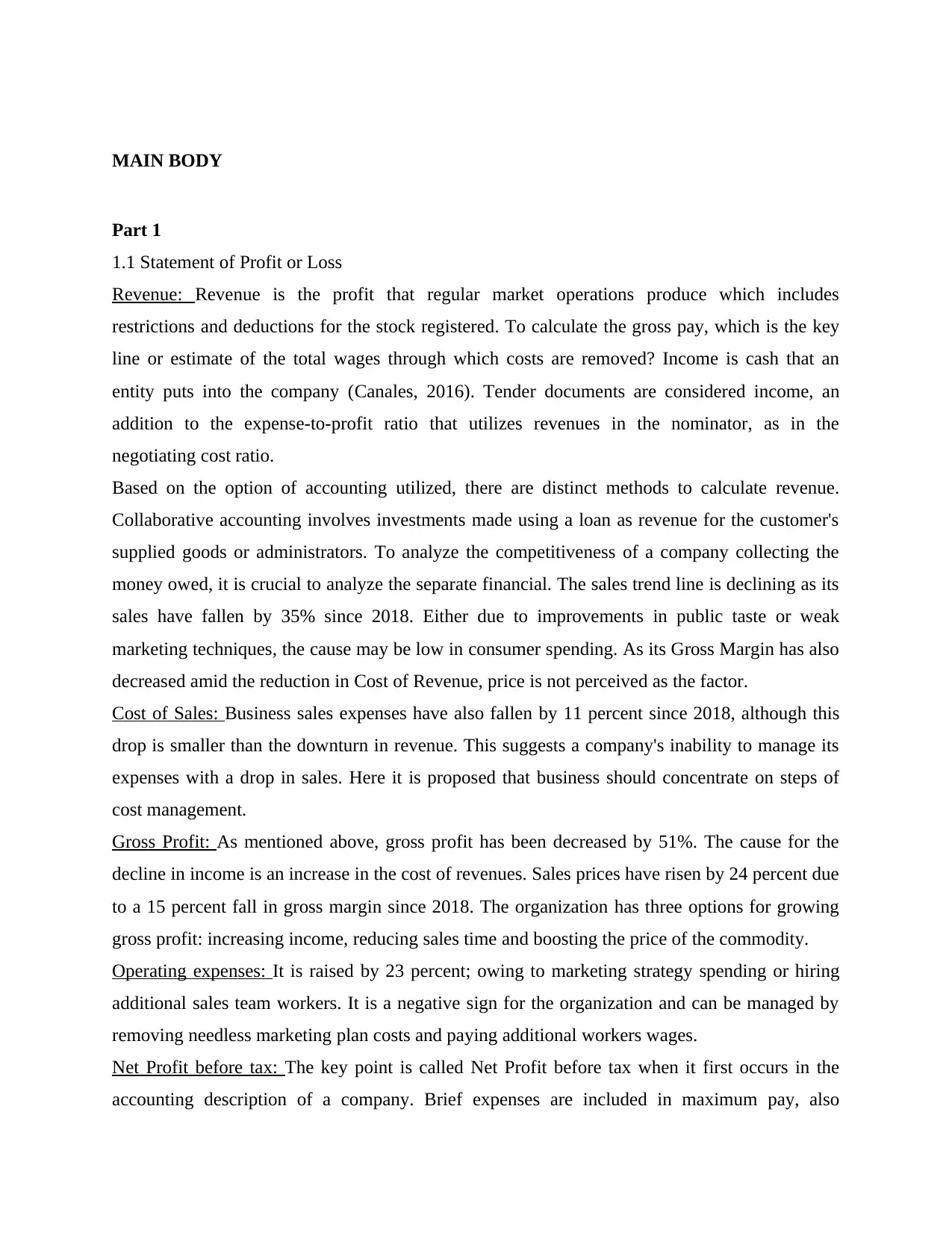
MAIN BODY
Part 1
1.1 Statement of Profit or Loss
Revenue: Revenue is the profit that regular market operations produce which includes
restrictions and deductions for the stock registered. To calculate the gross pay, which is the key
line or estimate of the total wages through which costs are removed? Income is cash that an
entity puts into the company (Canales, 2016). Tender documents are considered income, an
addition to the expense-to-profit ratio that utilizes revenues in the nominator, as in the
negotiating cost ratio.
Based on the option of accounting utilized, there are distinct methods to calculate revenue.
Collaborative accounting involves investments made using a loan as revenue for the customer's
supplied goods or administrators. To analyze the competitiveness of a company collecting the
money owed, it is crucial to analyze the separate financial. The sales trend line is declining as its
sales have fallen by 35% since 2018. Either due to improvements in public taste or weak
marketing techniques, the cause may be low in consumer spending. As its Gross Margin has also
decreased amid the reduction in Cost of Revenue, price is not perceived as the factor.
Cost of Sales: Business sales expenses have also fallen by 11 percent since 2018, although this
drop is smaller than the downturn in revenue. This suggests a company's inability to manage its
expenses with a drop in sales. Here it is proposed that business should concentrate on steps of
cost management.
Gross Profit: As mentioned above, gross profit has been decreased by 51%. The cause for the
decline in income is an increase in the cost of revenues. Sales prices have risen by 24 percent due
to a 15 percent fall in gross margin since 2018. The organization has three options for growing
gross profit: increasing income, reducing sales time and boosting the price of the commodity.
Operating expenses: It is raised by 23 percent; owing to marketing strategy spending or hiring
additional sales team workers. It is a negative sign for the organization and can be managed by
removing needless marketing plan costs and paying additional workers wages.
Net Profit before tax: The key point is called Net Profit before tax when it first occurs in the
accounting description of a company. Brief expenses are included in maximum pay, also
Part 1
1.1 Statement of Profit or Loss
Revenue: Revenue is the profit that regular market operations produce which includes
restrictions and deductions for the stock registered. To calculate the gross pay, which is the key
line or estimate of the total wages through which costs are removed? Income is cash that an
entity puts into the company (Canales, 2016). Tender documents are considered income, an
addition to the expense-to-profit ratio that utilizes revenues in the nominator, as in the
negotiating cost ratio.
Based on the option of accounting utilized, there are distinct methods to calculate revenue.
Collaborative accounting involves investments made using a loan as revenue for the customer's
supplied goods or administrators. To analyze the competitiveness of a company collecting the
money owed, it is crucial to analyze the separate financial. The sales trend line is declining as its
sales have fallen by 35% since 2018. Either due to improvements in public taste or weak
marketing techniques, the cause may be low in consumer spending. As its Gross Margin has also
decreased amid the reduction in Cost of Revenue, price is not perceived as the factor.
Cost of Sales: Business sales expenses have also fallen by 11 percent since 2018, although this
drop is smaller than the downturn in revenue. This suggests a company's inability to manage its
expenses with a drop in sales. Here it is proposed that business should concentrate on steps of
cost management.
Gross Profit: As mentioned above, gross profit has been decreased by 51%. The cause for the
decline in income is an increase in the cost of revenues. Sales prices have risen by 24 percent due
to a 15 percent fall in gross margin since 2018. The organization has three options for growing
gross profit: increasing income, reducing sales time and boosting the price of the commodity.
Operating expenses: It is raised by 23 percent; owing to marketing strategy spending or hiring
additional sales team workers. It is a negative sign for the organization and can be managed by
removing needless marketing plan costs and paying additional workers wages.
Net Profit before tax: The key point is called Net Profit before tax when it first occurs in the
accounting description of a company. Brief expenses are included in maximum pay, also
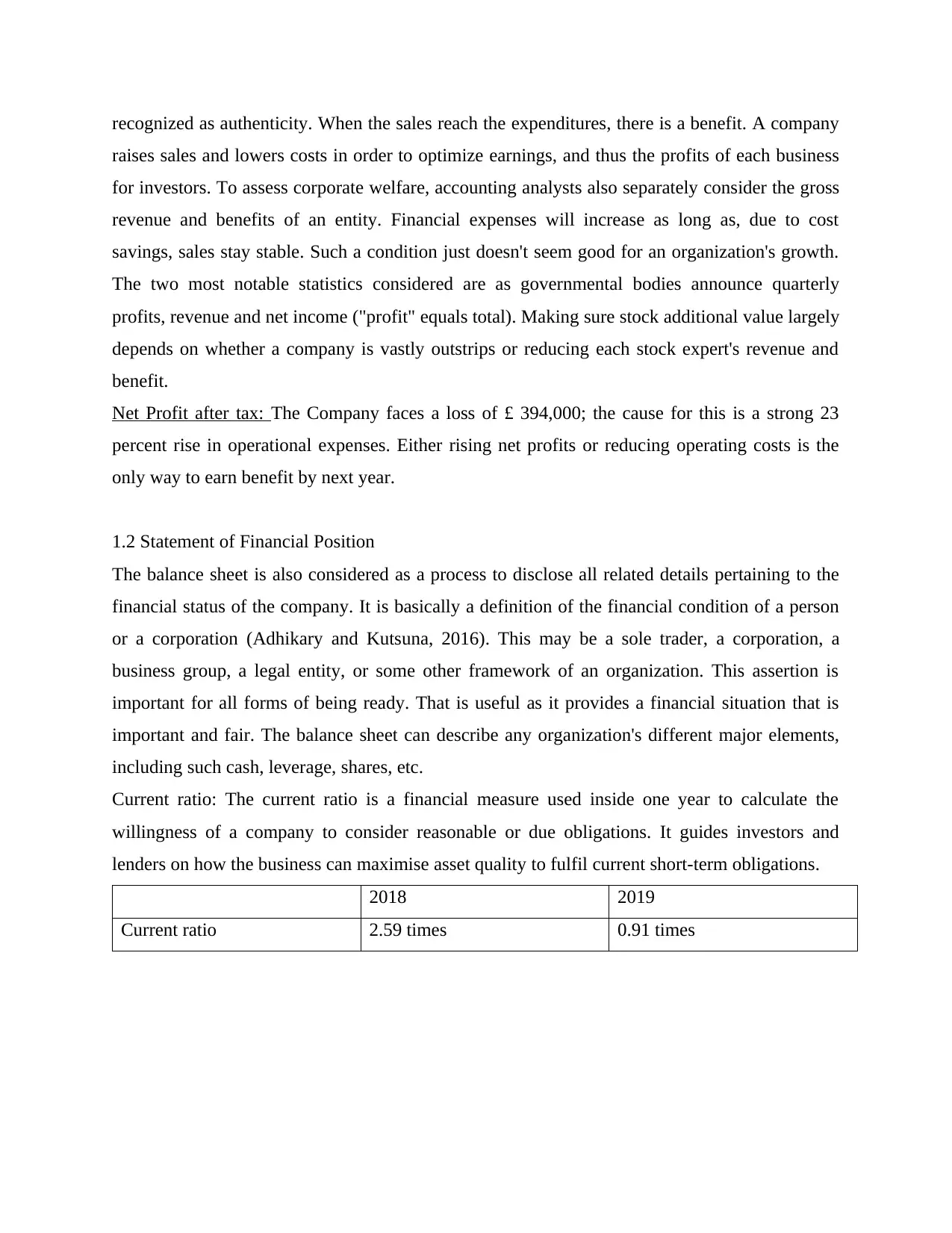
recognized as authenticity. When the sales reach the expenditures, there is a benefit. A company
raises sales and lowers costs in order to optimize earnings, and thus the profits of each business
for investors. To assess corporate welfare, accounting analysts also separately consider the gross
revenue and benefits of an entity. Financial expenses will increase as long as, due to cost
savings, sales stay stable. Such a condition just doesn't seem good for an organization's growth.
The two most notable statistics considered are as governmental bodies announce quarterly
profits, revenue and net income ("profit" equals total). Making sure stock additional value largely
depends on whether a company is vastly outstrips or reducing each stock expert's revenue and
benefit.
Net Profit after tax: The Company faces a loss of £ 394,000; the cause for this is a strong 23
percent rise in operational expenses. Either rising net profits or reducing operating costs is the
only way to earn benefit by next year.
1.2 Statement of Financial Position
The balance sheet is also considered as a process to disclose all related details pertaining to the
financial status of the company. It is basically a definition of the financial condition of a person
or a corporation (Adhikary and Kutsuna, 2016). This may be a sole trader, a corporation, a
business group, a legal entity, or some other framework of an organization. This assertion is
important for all forms of being ready. That is useful as it provides a financial situation that is
important and fair. The balance sheet can describe any organization's different major elements,
including such cash, leverage, shares, etc.
Current ratio: The current ratio is a financial measure used inside one year to calculate the
willingness of a company to consider reasonable or due obligations. It guides investors and
lenders on how the business can maximise asset quality to fulfil current short-term obligations.
2018 2019
Current ratio 2.59 times 0.91 times
raises sales and lowers costs in order to optimize earnings, and thus the profits of each business
for investors. To assess corporate welfare, accounting analysts also separately consider the gross
revenue and benefits of an entity. Financial expenses will increase as long as, due to cost
savings, sales stay stable. Such a condition just doesn't seem good for an organization's growth.
The two most notable statistics considered are as governmental bodies announce quarterly
profits, revenue and net income ("profit" equals total). Making sure stock additional value largely
depends on whether a company is vastly outstrips or reducing each stock expert's revenue and
benefit.
Net Profit after tax: The Company faces a loss of £ 394,000; the cause for this is a strong 23
percent rise in operational expenses. Either rising net profits or reducing operating costs is the
only way to earn benefit by next year.
1.2 Statement of Financial Position
The balance sheet is also considered as a process to disclose all related details pertaining to the
financial status of the company. It is basically a definition of the financial condition of a person
or a corporation (Adhikary and Kutsuna, 2016). This may be a sole trader, a corporation, a
business group, a legal entity, or some other framework of an organization. This assertion is
important for all forms of being ready. That is useful as it provides a financial situation that is
important and fair. The balance sheet can describe any organization's different major elements,
including such cash, leverage, shares, etc.
Current ratio: The current ratio is a financial measure used inside one year to calculate the
willingness of a company to consider reasonable or due obligations. It guides investors and
lenders on how the business can maximise asset quality to fulfil current short-term obligations.
2018 2019
Current ratio 2.59 times 0.91 times
Secure Best Marks with AI Grader
Need help grading? Try our AI Grader for instant feedback on your assignments.

Curr
ent
rati
o
In the year 2019, the following graph stated that the organization is struggling to meet an optimal
current ratio of 2:1 times. The corporation's ratio in 2018 was 2.59 times, while it was 0.91 times
in 2019. This means that the company is not in a position to expend its contract agreements on its
operating assets. There is also a need to control the specific issue so that the existing mix can be
optimized.
Receivable turnover ratio: It is a statistical metric used for both market growth and debt
accumulation to measure how profitable an organisation is (Jordà, Schularick and Taylor, 2016).
The turnover ratio of exchange accounts receivable is a useful ratio measuring how much the
organisation manages its funds.
2018 2019
Receivable turnover ratio 9.64 times 4.48 times
ent
rati
o
In the year 2019, the following graph stated that the organization is struggling to meet an optimal
current ratio of 2:1 times. The corporation's ratio in 2018 was 2.59 times, while it was 0.91 times
in 2019. This means that the company is not in a position to expend its contract agreements on its
operating assets. There is also a need to control the specific issue so that the existing mix can be
optimized.
Receivable turnover ratio: It is a statistical metric used for both market growth and debt
accumulation to measure how profitable an organisation is (Jordà, Schularick and Taylor, 2016).
The turnover ratio of exchange accounts receivable is a useful ratio measuring how much the
organisation manages its funds.
2018 2019
Receivable turnover ratio 9.64 times 4.48 times
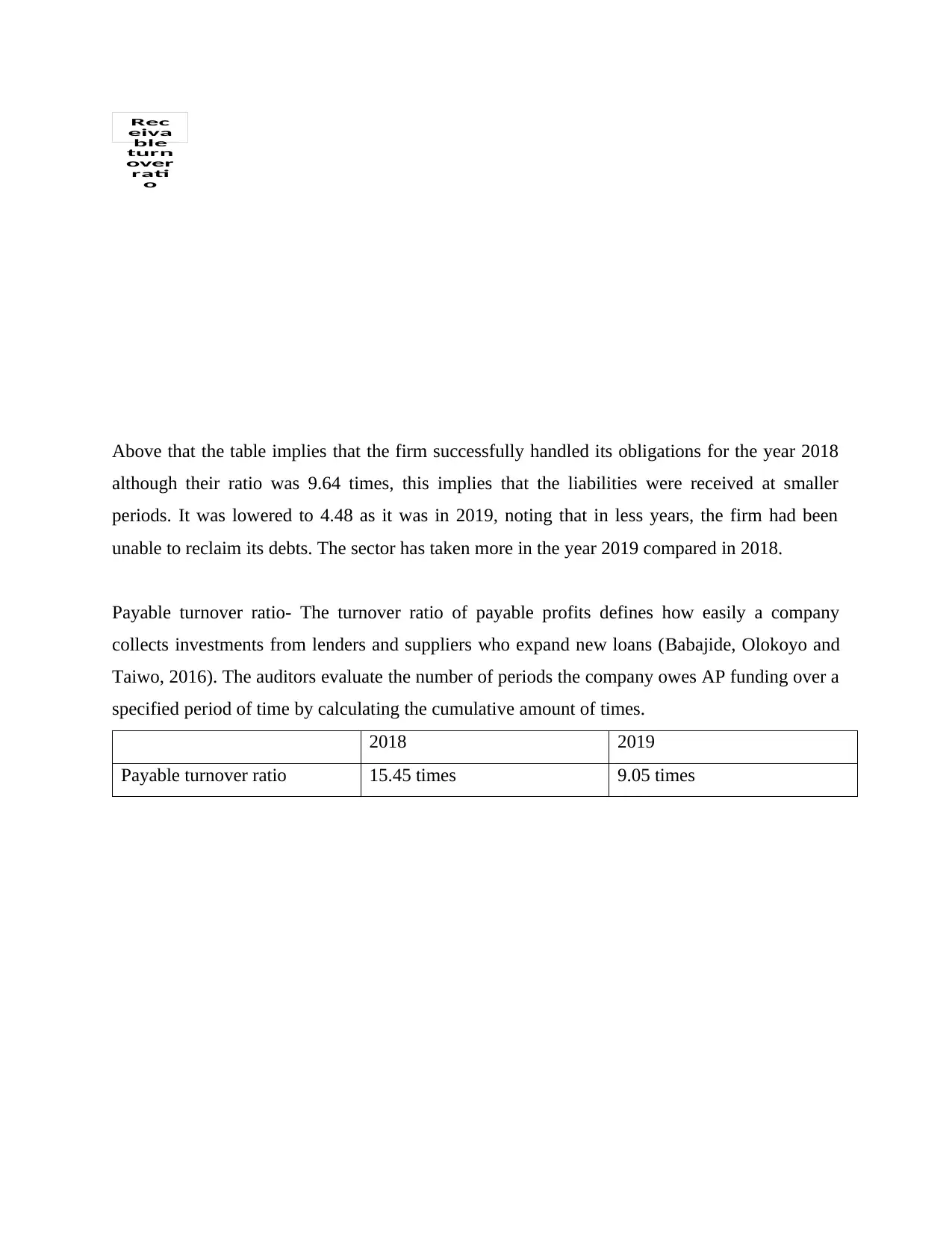
Rec
eiva
ble
turn
over
rati
o
Above that the table implies that the firm successfully handled its obligations for the year 2018
although their ratio was 9.64 times, this implies that the liabilities were received at smaller
periods. It was lowered to 4.48 as it was in 2019, noting that in less years, the firm had been
unable to reclaim its debts. The sector has taken more in the year 2019 compared in 2018.
Payable turnover ratio- The turnover ratio of payable profits defines how easily a company
collects investments from lenders and suppliers who expand new loans (Babajide, Olokoyo and
Taiwo, 2016). The auditors evaluate the number of periods the company owes AP funding over a
specified period of time by calculating the cumulative amount of times.
2018 2019
Payable turnover ratio 15.45 times 9.05 times
eiva
ble
turn
over
rati
o
Above that the table implies that the firm successfully handled its obligations for the year 2018
although their ratio was 9.64 times, this implies that the liabilities were received at smaller
periods. It was lowered to 4.48 as it was in 2019, noting that in less years, the firm had been
unable to reclaim its debts. The sector has taken more in the year 2019 compared in 2018.
Payable turnover ratio- The turnover ratio of payable profits defines how easily a company
collects investments from lenders and suppliers who expand new loans (Babajide, Olokoyo and
Taiwo, 2016). The auditors evaluate the number of periods the company owes AP funding over a
specified period of time by calculating the cumulative amount of times.
2018 2019
Payable turnover ratio 15.45 times 9.05 times
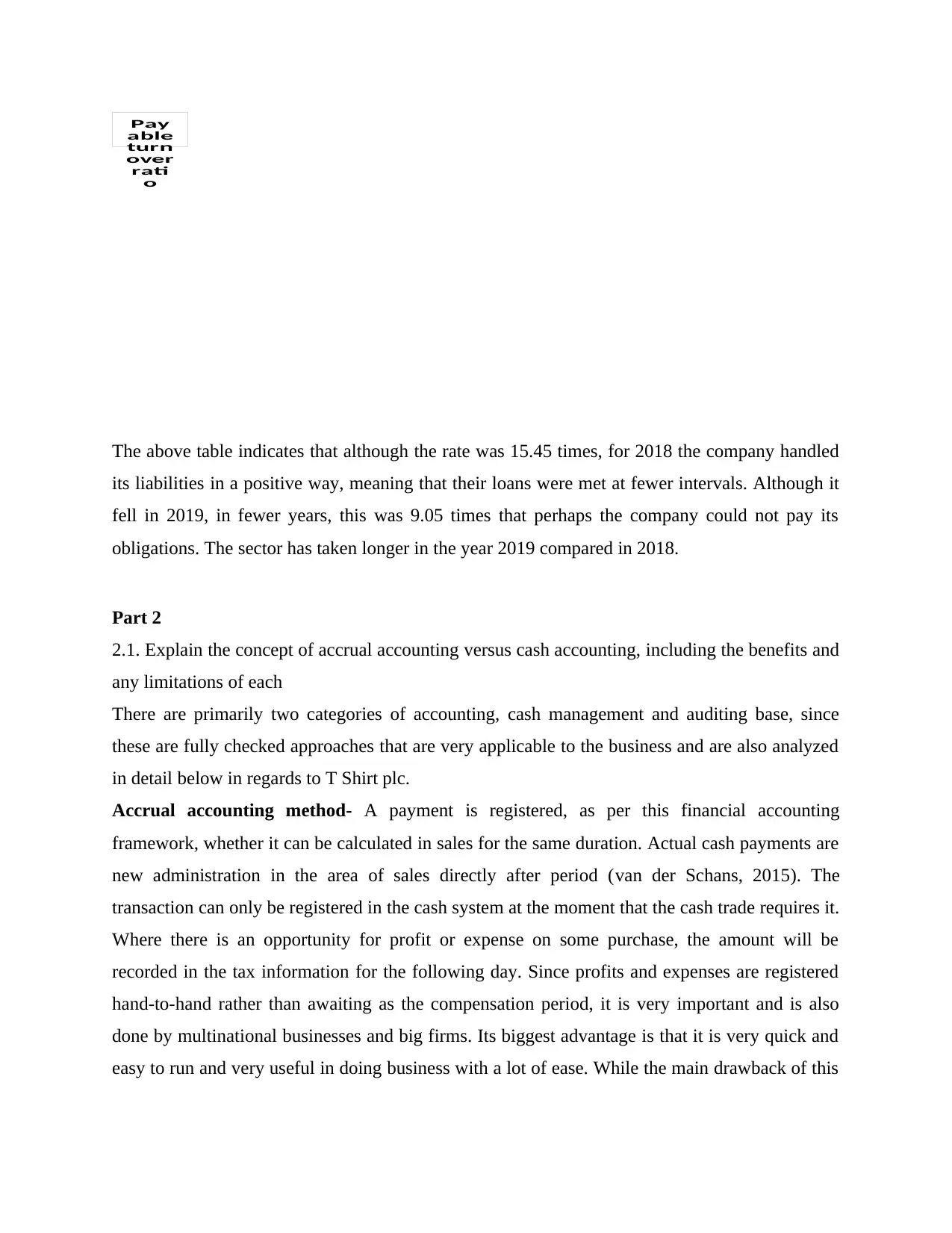
Pay
able
turn
over
rati
o
The above table indicates that although the rate was 15.45 times, for 2018 the company handled
its liabilities in a positive way, meaning that their loans were met at fewer intervals. Although it
fell in 2019, in fewer years, this was 9.05 times that perhaps the company could not pay its
obligations. The sector has taken longer in the year 2019 compared in 2018.
Part 2
2.1. Explain the concept of accrual accounting versus cash accounting, including the benefits and
any limitations of each
There are primarily two categories of accounting, cash management and auditing base, since
these are fully checked approaches that are very applicable to the business and are also analyzed
in detail below in regards to T Shirt plc.
Accrual accounting method- A payment is registered, as per this financial accounting
framework, whether it can be calculated in sales for the same duration. Actual cash payments are
new administration in the area of sales directly after period (van der Schans, 2015). The
transaction can only be registered in the cash system at the moment that the cash trade requires it.
Where there is an opportunity for profit or expense on some purchase, the amount will be
recorded in the tax information for the following day. Since profits and expenses are registered
hand-to-hand rather than awaiting as the compensation period, it is very important and is also
done by multinational businesses and big firms. Its biggest advantage is that it is very quick and
easy to run and very useful in doing business with a lot of ease. While the main drawback of this
able
turn
over
rati
o
The above table indicates that although the rate was 15.45 times, for 2018 the company handled
its liabilities in a positive way, meaning that their loans were met at fewer intervals. Although it
fell in 2019, in fewer years, this was 9.05 times that perhaps the company could not pay its
obligations. The sector has taken longer in the year 2019 compared in 2018.
Part 2
2.1. Explain the concept of accrual accounting versus cash accounting, including the benefits and
any limitations of each
There are primarily two categories of accounting, cash management and auditing base, since
these are fully checked approaches that are very applicable to the business and are also analyzed
in detail below in regards to T Shirt plc.
Accrual accounting method- A payment is registered, as per this financial accounting
framework, whether it can be calculated in sales for the same duration. Actual cash payments are
new administration in the area of sales directly after period (van der Schans, 2015). The
transaction can only be registered in the cash system at the moment that the cash trade requires it.
Where there is an opportunity for profit or expense on some purchase, the amount will be
recorded in the tax information for the following day. Since profits and expenses are registered
hand-to-hand rather than awaiting as the compensation period, it is very important and is also
done by multinational businesses and big firms. Its biggest advantage is that it is very quick and
easy to run and very useful in doing business with a lot of ease. While the main drawback of this
Paraphrase This Document
Need a fresh take? Get an instant paraphrase of this document with our AI Paraphraser
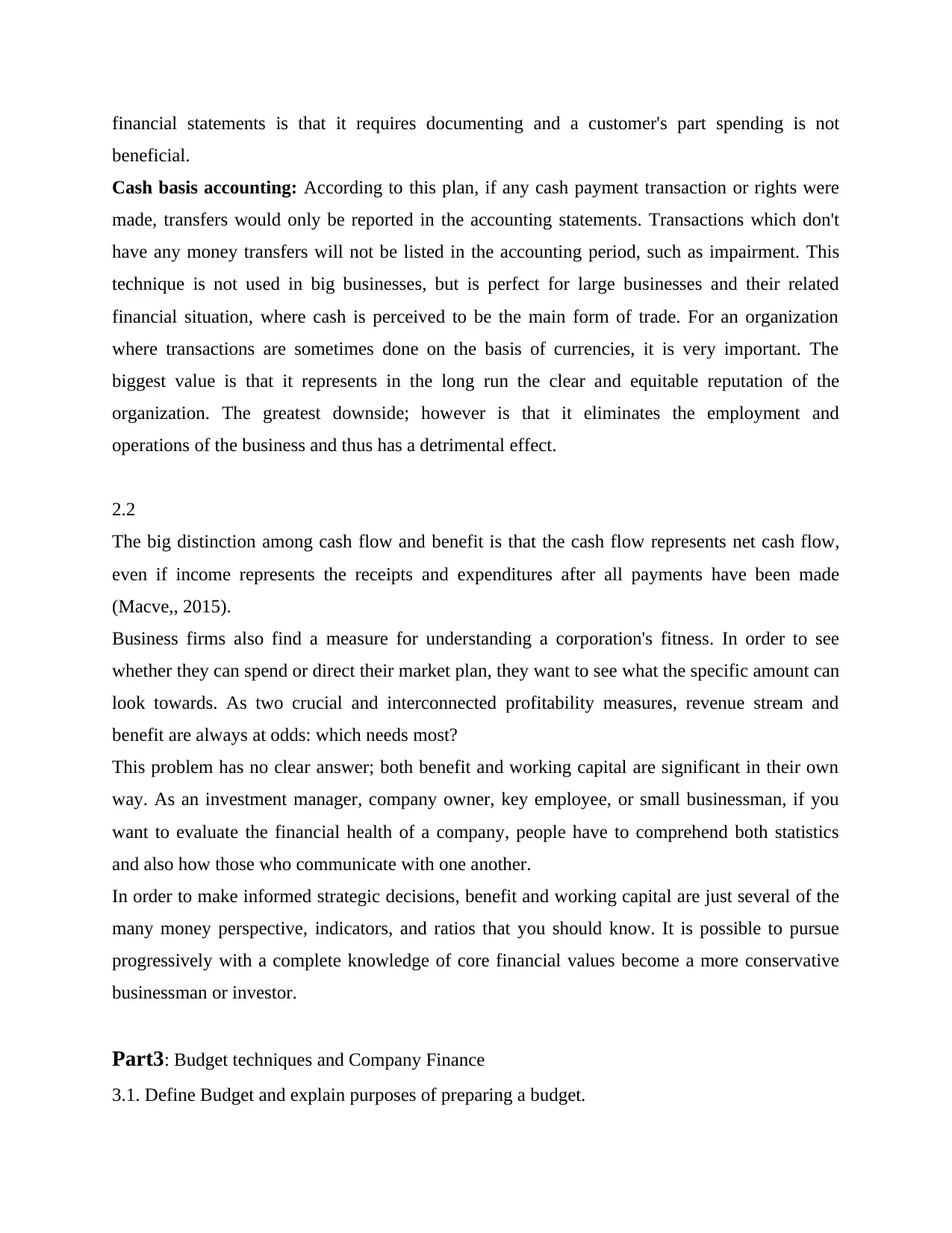
financial statements is that it requires documenting and a customer's part spending is not
beneficial.
Cash basis accounting: According to this plan, if any cash payment transaction or rights were
made, transfers would only be reported in the accounting statements. Transactions which don't
have any money transfers will not be listed in the accounting period, such as impairment. This
technique is not used in big businesses, but is perfect for large businesses and their related
financial situation, where cash is perceived to be the main form of trade. For an organization
where transactions are sometimes done on the basis of currencies, it is very important. The
biggest value is that it represents in the long run the clear and equitable reputation of the
organization. The greatest downside; however is that it eliminates the employment and
operations of the business and thus has a detrimental effect.
2.2
The big distinction among cash flow and benefit is that the cash flow represents net cash flow,
even if income represents the receipts and expenditures after all payments have been made
(Macve,, 2015).
Business firms also find a measure for understanding a corporation's fitness. In order to see
whether they can spend or direct their market plan, they want to see what the specific amount can
look towards. As two crucial and interconnected profitability measures, revenue stream and
benefit are always at odds: which needs most?
This problem has no clear answer; both benefit and working capital are significant in their own
way. As an investment manager, company owner, key employee, or small businessman, if you
want to evaluate the financial health of a company, people have to comprehend both statistics
and also how those who communicate with one another.
In order to make informed strategic decisions, benefit and working capital are just several of the
many money perspective, indicators, and ratios that you should know. It is possible to pursue
progressively with a complete knowledge of core financial values become a more conservative
businessman or investor.
Part3: Budget techniques and Company Finance
3.1. Define Budget and explain purposes of preparing a budget.
beneficial.
Cash basis accounting: According to this plan, if any cash payment transaction or rights were
made, transfers would only be reported in the accounting statements. Transactions which don't
have any money transfers will not be listed in the accounting period, such as impairment. This
technique is not used in big businesses, but is perfect for large businesses and their related
financial situation, where cash is perceived to be the main form of trade. For an organization
where transactions are sometimes done on the basis of currencies, it is very important. The
biggest value is that it represents in the long run the clear and equitable reputation of the
organization. The greatest downside; however is that it eliminates the employment and
operations of the business and thus has a detrimental effect.
2.2
The big distinction among cash flow and benefit is that the cash flow represents net cash flow,
even if income represents the receipts and expenditures after all payments have been made
(Macve,, 2015).
Business firms also find a measure for understanding a corporation's fitness. In order to see
whether they can spend or direct their market plan, they want to see what the specific amount can
look towards. As two crucial and interconnected profitability measures, revenue stream and
benefit are always at odds: which needs most?
This problem has no clear answer; both benefit and working capital are significant in their own
way. As an investment manager, company owner, key employee, or small businessman, if you
want to evaluate the financial health of a company, people have to comprehend both statistics
and also how those who communicate with one another.
In order to make informed strategic decisions, benefit and working capital are just several of the
many money perspective, indicators, and ratios that you should know. It is possible to pursue
progressively with a complete knowledge of core financial values become a more conservative
businessman or investor.
Part3: Budget techniques and Company Finance
3.1. Define Budget and explain purposes of preparing a budget.
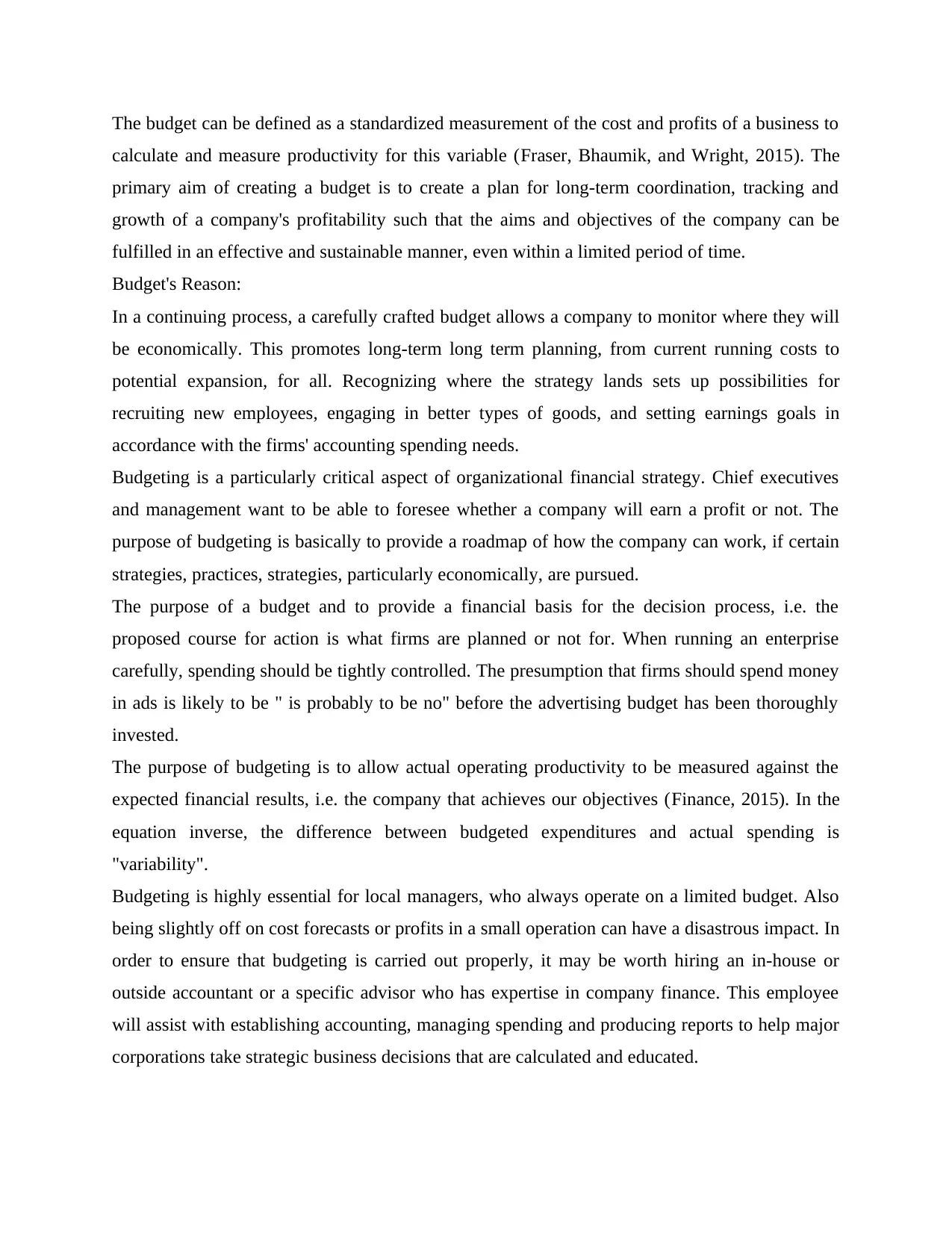
The budget can be defined as a standardized measurement of the cost and profits of a business to
calculate and measure productivity for this variable (Fraser, Bhaumik, and Wright, 2015). The
primary aim of creating a budget is to create a plan for long-term coordination, tracking and
growth of a company's profitability such that the aims and objectives of the company can be
fulfilled in an effective and sustainable manner, even within a limited period of time.
Budget's Reason:
In a continuing process, a carefully crafted budget allows a company to monitor where they will
be economically. This promotes long-term long term planning, from current running costs to
potential expansion, for all. Recognizing where the strategy lands sets up possibilities for
recruiting new employees, engaging in better types of goods, and setting earnings goals in
accordance with the firms' accounting spending needs.
Budgeting is a particularly critical aspect of organizational financial strategy. Chief executives
and management want to be able to foresee whether a company will earn a profit or not. The
purpose of budgeting is basically to provide a roadmap of how the company can work, if certain
strategies, practices, strategies, particularly economically, are pursued.
The purpose of a budget and to provide a financial basis for the decision process, i.e. the
proposed course for action is what firms are planned or not for. When running an enterprise
carefully, spending should be tightly controlled. The presumption that firms should spend money
in ads is likely to be " is probably to be no" before the advertising budget has been thoroughly
invested.
The purpose of budgeting is to allow actual operating productivity to be measured against the
expected financial results, i.e. the company that achieves our objectives (Finance, 2015). In the
equation inverse, the difference between budgeted expenditures and actual spending is
"variability".
Budgeting is highly essential for local managers, who always operate on a limited budget. Also
being slightly off on cost forecasts or profits in a small operation can have a disastrous impact. In
order to ensure that budgeting is carried out properly, it may be worth hiring an in-house or
outside accountant or a specific advisor who has expertise in company finance. This employee
will assist with establishing accounting, managing spending and producing reports to help major
corporations take strategic business decisions that are calculated and educated.
calculate and measure productivity for this variable (Fraser, Bhaumik, and Wright, 2015). The
primary aim of creating a budget is to create a plan for long-term coordination, tracking and
growth of a company's profitability such that the aims and objectives of the company can be
fulfilled in an effective and sustainable manner, even within a limited period of time.
Budget's Reason:
In a continuing process, a carefully crafted budget allows a company to monitor where they will
be economically. This promotes long-term long term planning, from current running costs to
potential expansion, for all. Recognizing where the strategy lands sets up possibilities for
recruiting new employees, engaging in better types of goods, and setting earnings goals in
accordance with the firms' accounting spending needs.
Budgeting is a particularly critical aspect of organizational financial strategy. Chief executives
and management want to be able to foresee whether a company will earn a profit or not. The
purpose of budgeting is basically to provide a roadmap of how the company can work, if certain
strategies, practices, strategies, particularly economically, are pursued.
The purpose of a budget and to provide a financial basis for the decision process, i.e. the
proposed course for action is what firms are planned or not for. When running an enterprise
carefully, spending should be tightly controlled. The presumption that firms should spend money
in ads is likely to be " is probably to be no" before the advertising budget has been thoroughly
invested.
The purpose of budgeting is to allow actual operating productivity to be measured against the
expected financial results, i.e. the company that achieves our objectives (Finance, 2015). In the
equation inverse, the difference between budgeted expenditures and actual spending is
"variability".
Budgeting is highly essential for local managers, who always operate on a limited budget. Also
being slightly off on cost forecasts or profits in a small operation can have a disastrous impact. In
order to ensure that budgeting is carried out properly, it may be worth hiring an in-house or
outside accountant or a specific advisor who has expertise in company finance. This employee
will assist with establishing accounting, managing spending and producing reports to help major
corporations take strategic business decisions that are calculated and educated.
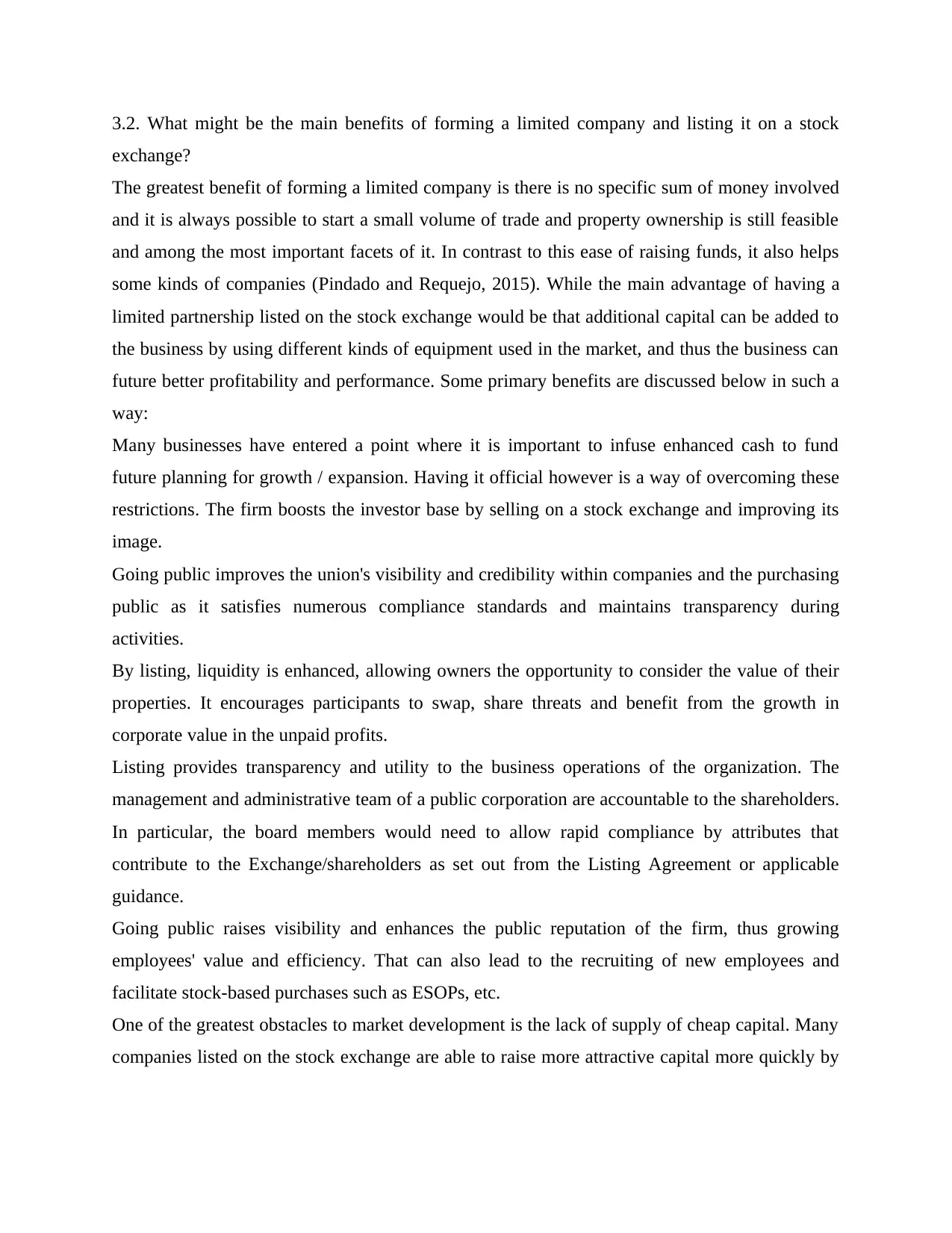
3.2. What might be the main benefits of forming a limited company and listing it on a stock
exchange?
The greatest benefit of forming a limited company is there is no specific sum of money involved
and it is always possible to start a small volume of trade and property ownership is still feasible
and among the most important facets of it. In contrast to this ease of raising funds, it also helps
some kinds of companies (Pindado and Requejo, 2015). While the main advantage of having a
limited partnership listed on the stock exchange would be that additional capital can be added to
the business by using different kinds of equipment used in the market, and thus the business can
future better profitability and performance. Some primary benefits are discussed below in such a
way:
Many businesses have entered a point where it is important to infuse enhanced cash to fund
future planning for growth / expansion. Having it official however is a way of overcoming these
restrictions. The firm boosts the investor base by selling on a stock exchange and improving its
image.
Going public improves the union's visibility and credibility within companies and the purchasing
public as it satisfies numerous compliance standards and maintains transparency during
activities.
By listing, liquidity is enhanced, allowing owners the opportunity to consider the value of their
properties. It encourages participants to swap, share threats and benefit from the growth in
corporate value in the unpaid profits.
Listing provides transparency and utility to the business operations of the organization. The
management and administrative team of a public corporation are accountable to the shareholders.
In particular, the board members would need to allow rapid compliance by attributes that
contribute to the Exchange/shareholders as set out from the Listing Agreement or applicable
guidance.
Going public raises visibility and enhances the public reputation of the firm, thus growing
employees' value and efficiency. That can also lead to the recruiting of new employees and
facilitate stock-based purchases such as ESOPs, etc.
One of the greatest obstacles to market development is the lack of supply of cheap capital. Many
companies listed on the stock exchange are able to raise more attractive capital more quickly by
exchange?
The greatest benefit of forming a limited company is there is no specific sum of money involved
and it is always possible to start a small volume of trade and property ownership is still feasible
and among the most important facets of it. In contrast to this ease of raising funds, it also helps
some kinds of companies (Pindado and Requejo, 2015). While the main advantage of having a
limited partnership listed on the stock exchange would be that additional capital can be added to
the business by using different kinds of equipment used in the market, and thus the business can
future better profitability and performance. Some primary benefits are discussed below in such a
way:
Many businesses have entered a point where it is important to infuse enhanced cash to fund
future planning for growth / expansion. Having it official however is a way of overcoming these
restrictions. The firm boosts the investor base by selling on a stock exchange and improving its
image.
Going public improves the union's visibility and credibility within companies and the purchasing
public as it satisfies numerous compliance standards and maintains transparency during
activities.
By listing, liquidity is enhanced, allowing owners the opportunity to consider the value of their
properties. It encourages participants to swap, share threats and benefit from the growth in
corporate value in the unpaid profits.
Listing provides transparency and utility to the business operations of the organization. The
management and administrative team of a public corporation are accountable to the shareholders.
In particular, the board members would need to allow rapid compliance by attributes that
contribute to the Exchange/shareholders as set out from the Listing Agreement or applicable
guidance.
Going public raises visibility and enhances the public reputation of the firm, thus growing
employees' value and efficiency. That can also lead to the recruiting of new employees and
facilitate stock-based purchases such as ESOPs, etc.
One of the greatest obstacles to market development is the lack of supply of cheap capital. Many
companies listed on the stock exchange are able to raise more attractive capital more quickly by
Secure Best Marks with AI Grader
Need help grading? Try our AI Grader for instant feedback on your assignments.
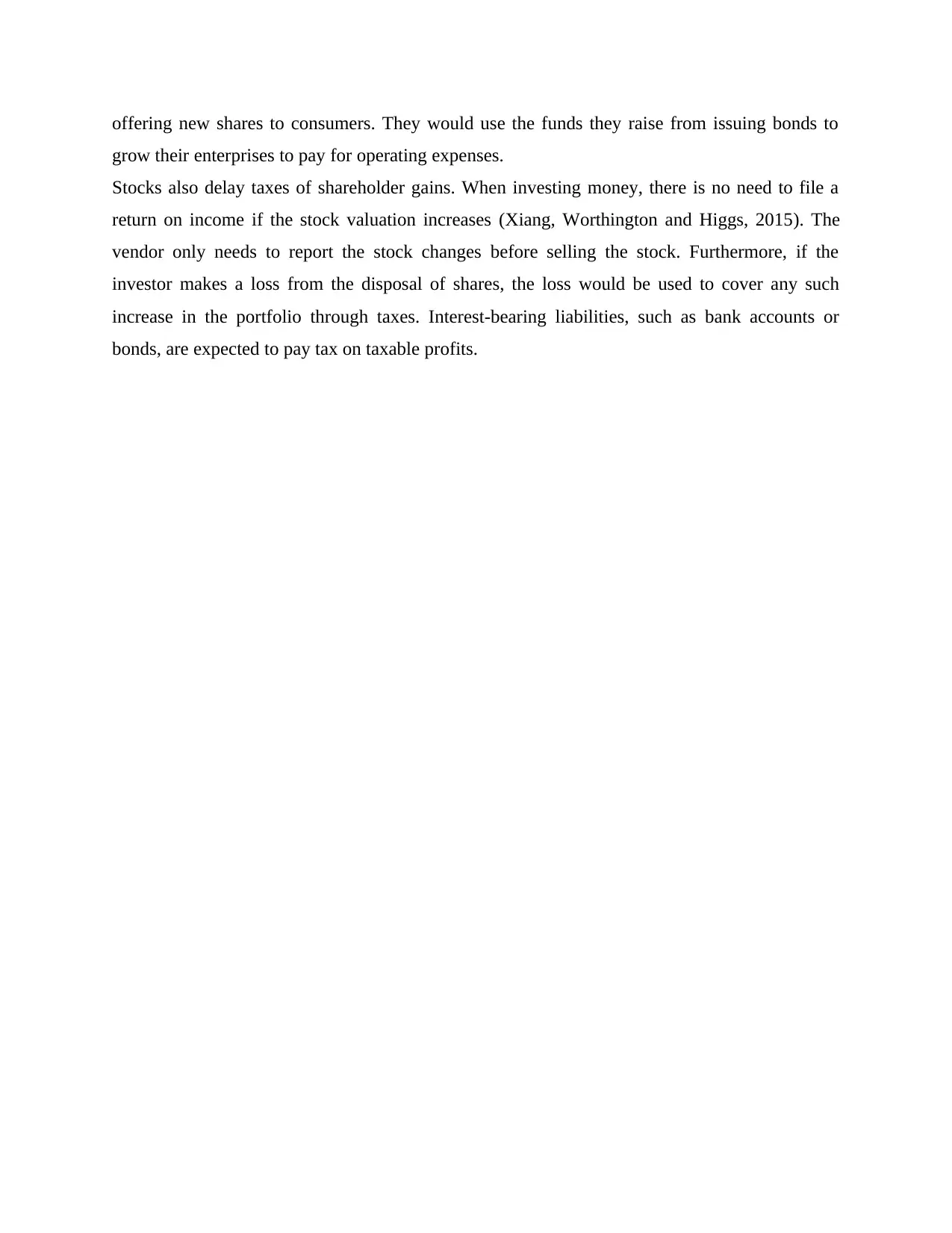
offering new shares to consumers. They would use the funds they raise from issuing bonds to
grow their enterprises to pay for operating expenses.
Stocks also delay taxes of shareholder gains. When investing money, there is no need to file a
return on income if the stock valuation increases (Xiang, Worthington and Higgs, 2015). The
vendor only needs to report the stock changes before selling the stock. Furthermore, if the
investor makes a loss from the disposal of shares, the loss would be used to cover any such
increase in the portfolio through taxes. Interest-bearing liabilities, such as bank accounts or
bonds, are expected to pay tax on taxable profits.
grow their enterprises to pay for operating expenses.
Stocks also delay taxes of shareholder gains. When investing money, there is no need to file a
return on income if the stock valuation increases (Xiang, Worthington and Higgs, 2015). The
vendor only needs to report the stock changes before selling the stock. Furthermore, if the
investor makes a loss from the disposal of shares, the loss would be used to cover any such
increase in the portfolio through taxes. Interest-bearing liabilities, such as bank accounts or
bonds, are expected to pay tax on taxable profits.
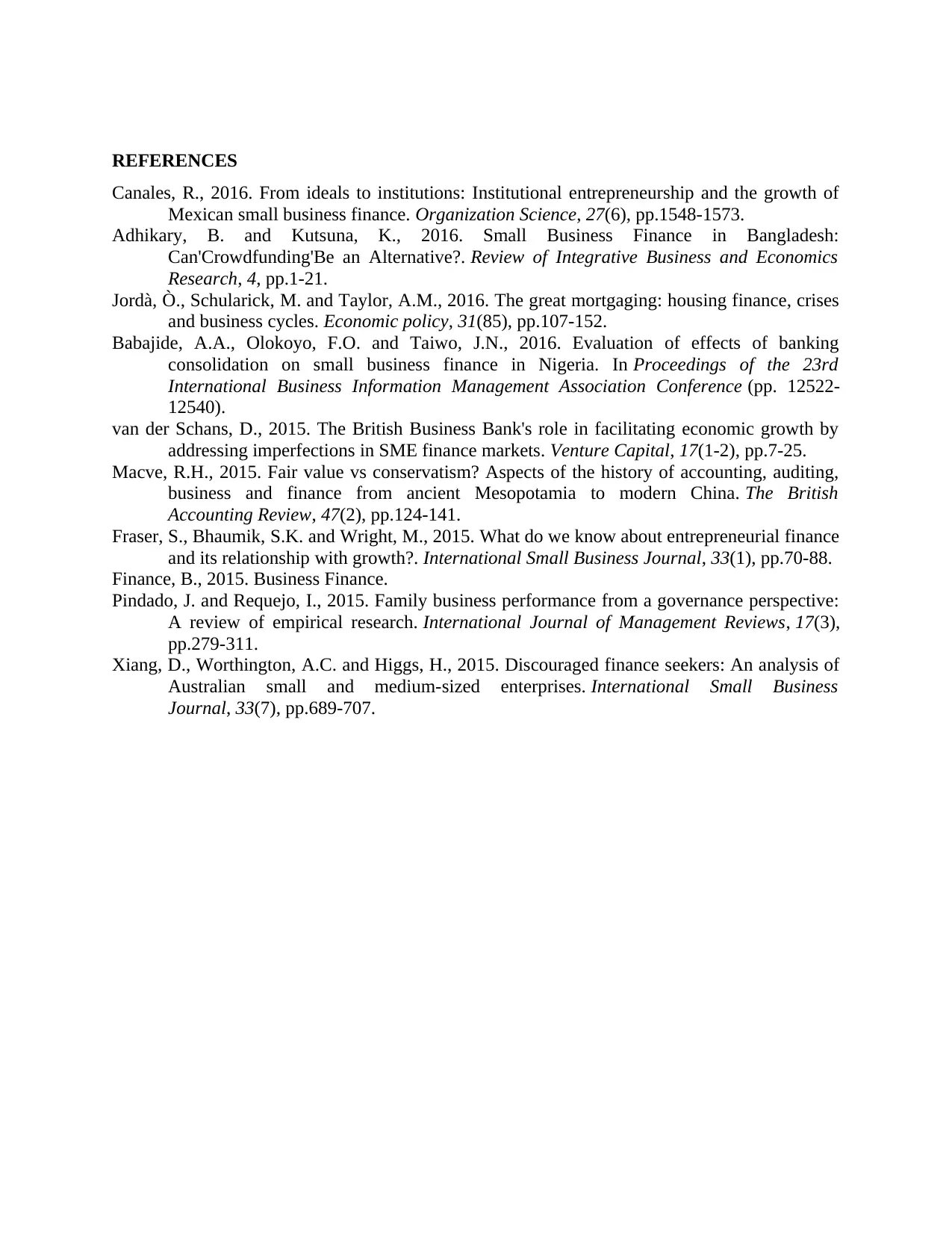
REFERENCES
Canales, R., 2016. From ideals to institutions: Institutional entrepreneurship and the growth of
Mexican small business finance. Organization Science, 27(6), pp.1548-1573.
Adhikary, B. and Kutsuna, K., 2016. Small Business Finance in Bangladesh:
Can'Crowdfunding'Be an Alternative?. Review of Integrative Business and Economics
Research, 4, pp.1-21.
Jordà, Ò., Schularick, M. and Taylor, A.M., 2016. The great mortgaging: housing finance, crises
and business cycles. Economic policy, 31(85), pp.107-152.
Babajide, A.A., Olokoyo, F.O. and Taiwo, J.N., 2016. Evaluation of effects of banking
consolidation on small business finance in Nigeria. In Proceedings of the 23rd
International Business Information Management Association Conference (pp. 12522-
12540).
van der Schans, D., 2015. The British Business Bank's role in facilitating economic growth by
addressing imperfections in SME finance markets. Venture Capital, 17(1-2), pp.7-25.
Macve, R.H., 2015. Fair value vs conservatism? Aspects of the history of accounting, auditing,
business and finance from ancient Mesopotamia to modern China. The British
Accounting Review, 47(2), pp.124-141.
Fraser, S., Bhaumik, S.K. and Wright, M., 2015. What do we know about entrepreneurial finance
and its relationship with growth?. International Small Business Journal, 33(1), pp.70-88.
Finance, B., 2015. Business Finance.
Pindado, J. and Requejo, I., 2015. Family business performance from a governance perspective:
A review of empirical research. International Journal of Management Reviews, 17(3),
pp.279-311.
Xiang, D., Worthington, A.C. and Higgs, H., 2015. Discouraged finance seekers: An analysis of
Australian small and medium-sized enterprises. International Small Business
Journal, 33(7), pp.689-707.
Canales, R., 2016. From ideals to institutions: Institutional entrepreneurship and the growth of
Mexican small business finance. Organization Science, 27(6), pp.1548-1573.
Adhikary, B. and Kutsuna, K., 2016. Small Business Finance in Bangladesh:
Can'Crowdfunding'Be an Alternative?. Review of Integrative Business and Economics
Research, 4, pp.1-21.
Jordà, Ò., Schularick, M. and Taylor, A.M., 2016. The great mortgaging: housing finance, crises
and business cycles. Economic policy, 31(85), pp.107-152.
Babajide, A.A., Olokoyo, F.O. and Taiwo, J.N., 2016. Evaluation of effects of banking
consolidation on small business finance in Nigeria. In Proceedings of the 23rd
International Business Information Management Association Conference (pp. 12522-
12540).
van der Schans, D., 2015. The British Business Bank's role in facilitating economic growth by
addressing imperfections in SME finance markets. Venture Capital, 17(1-2), pp.7-25.
Macve, R.H., 2015. Fair value vs conservatism? Aspects of the history of accounting, auditing,
business and finance from ancient Mesopotamia to modern China. The British
Accounting Review, 47(2), pp.124-141.
Fraser, S., Bhaumik, S.K. and Wright, M., 2015. What do we know about entrepreneurial finance
and its relationship with growth?. International Small Business Journal, 33(1), pp.70-88.
Finance, B., 2015. Business Finance.
Pindado, J. and Requejo, I., 2015. Family business performance from a governance perspective:
A review of empirical research. International Journal of Management Reviews, 17(3),
pp.279-311.
Xiang, D., Worthington, A.C. and Higgs, H., 2015. Discouraged finance seekers: An analysis of
Australian small and medium-sized enterprises. International Small Business
Journal, 33(7), pp.689-707.
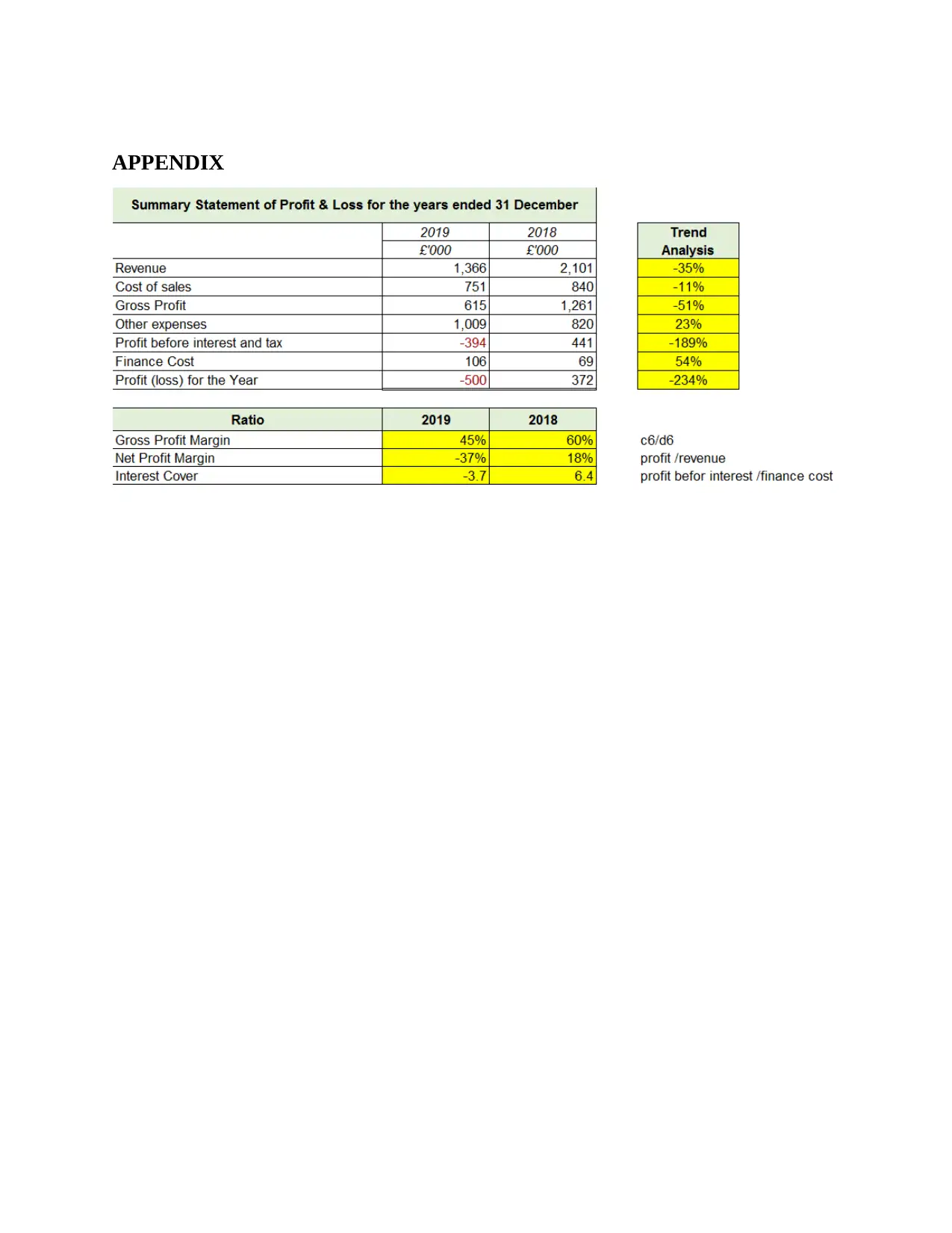
APPENDIX
Paraphrase This Document
Need a fresh take? Get an instant paraphrase of this document with our AI Paraphraser
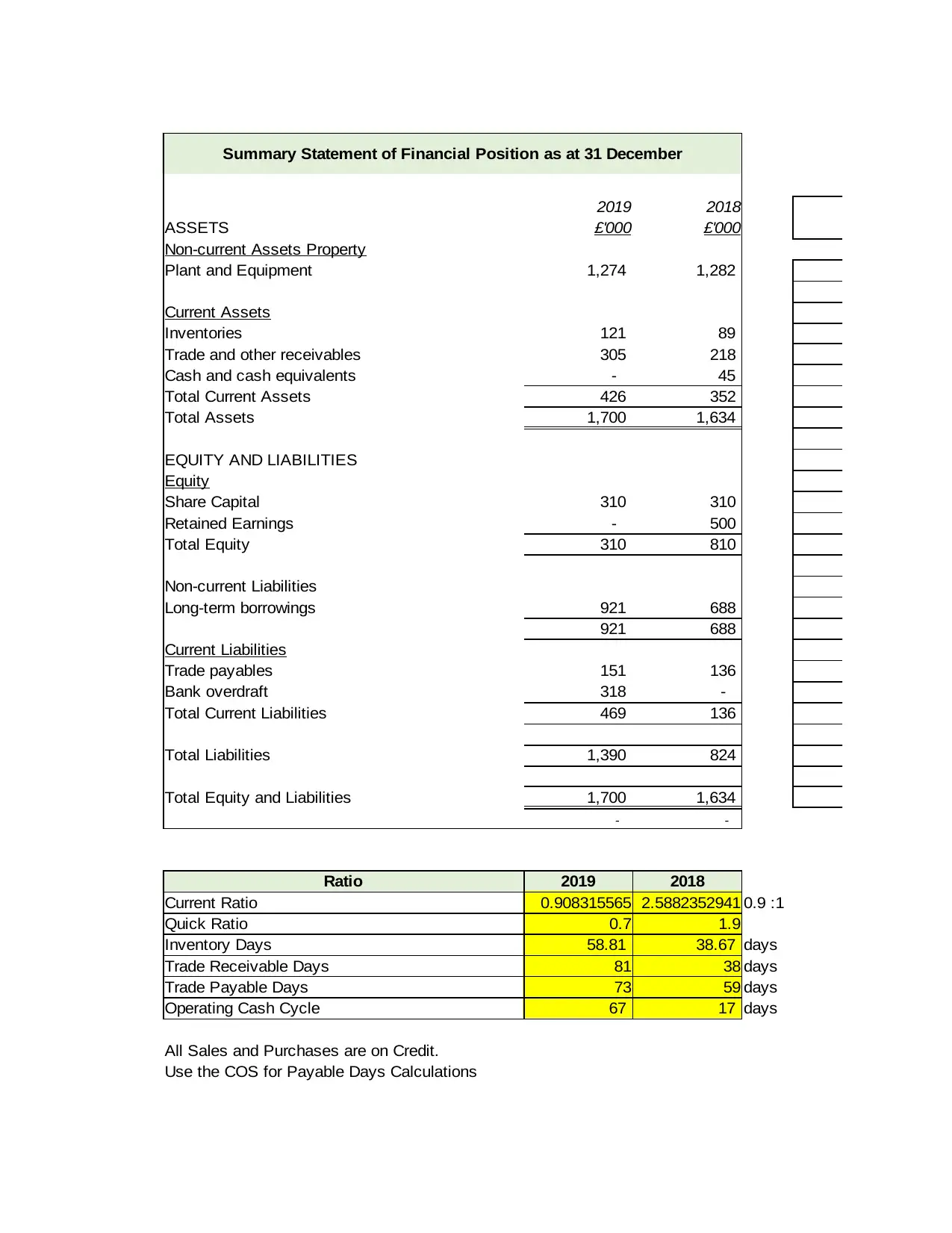
Summary Statement of Financial Position as at 31 December
2019 2018
ASSETS £'000 £'000
Non-current Assets Property
Plant and Equipment 1,274 1,282
Current Assets
Inventories 121 89
Trade and other receivables 305 218
Cash and cash equivalents - 45
Total Current Assets 426 352
Total Assets 1,700 1,634
EQUITY AND LIABILITIES
Equity
Share Capital 310 310
Retained Earnings - 500
Total Equity 310 810
Non-current Liabilities
Long-term borrowings 921 688
921 688
Current Liabilities
Trade payables 151 136
Bank overdraft 318 -
Total Current Liabilities 469 136
Total Liabilities 1,390 824
Total Equity and Liabilities 1,700 1,634
- -
Ratio 2019 2018
Current Ratio 0.908315565 2.5882352941 0.9 :1
Quick Ratio 0.7 1.9
Inventory Days 58.81 38.67 days
Trade Receivable Days 81 38 days
Trade Payable Days 73 59 days
Operating Cash Cycle 67 17 days
All Sales and Purchases are on Credit.
Use the COS for Payable Days Calculations
2019 2018
ASSETS £'000 £'000
Non-current Assets Property
Plant and Equipment 1,274 1,282
Current Assets
Inventories 121 89
Trade and other receivables 305 218
Cash and cash equivalents - 45
Total Current Assets 426 352
Total Assets 1,700 1,634
EQUITY AND LIABILITIES
Equity
Share Capital 310 310
Retained Earnings - 500
Total Equity 310 810
Non-current Liabilities
Long-term borrowings 921 688
921 688
Current Liabilities
Trade payables 151 136
Bank overdraft 318 -
Total Current Liabilities 469 136
Total Liabilities 1,390 824
Total Equity and Liabilities 1,700 1,634
- -
Ratio 2019 2018
Current Ratio 0.908315565 2.5882352941 0.9 :1
Quick Ratio 0.7 1.9
Inventory Days 58.81 38.67 days
Trade Receivable Days 81 38 days
Trade Payable Days 73 59 days
Operating Cash Cycle 67 17 days
All Sales and Purchases are on Credit.
Use the COS for Payable Days Calculations
1 out of 14
Related Documents
Your All-in-One AI-Powered Toolkit for Academic Success.
+13062052269
info@desklib.com
Available 24*7 on WhatsApp / Email
![[object Object]](/_next/static/media/star-bottom.7253800d.svg)
Unlock your academic potential
© 2024 | Zucol Services PVT LTD | All rights reserved.




